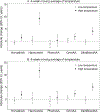Associations between medium- and long-term exposure to air temperature and epigenetic age acceleration
- PMID: 37517177
- PMCID: PMC10656697
- DOI: 10.1016/j.envint.2023.108109
Associations between medium- and long-term exposure to air temperature and epigenetic age acceleration
Abstract
Climate change poses a serious threat to human health worldwide, while aging populations increase. However, no study has ever investigated the effects of air temperature on epigenetic age acceleration. This study involved 1,725 and 1,877 participants from the population-based KORA F4 (2006-2008) and follow-up FF4 (2013-2014) studies, respectively, conducted in Augsburg, Germany. The difference between epigenetic age and chronological age was referred to as epigenetic age acceleration and reflected by Horvath's epigenetic age acceleration (HorvathAA), Hannum's epigenetic age acceleration (HannumAA), PhenoAge acceleration (PhenoAA), GrimAge acceleration (GrimAA), and Epigenetic Skin and Blood Age acceleration (SkinBloodAA). Daily air temperature was estimated using hybrid spatiotemporal regression-based models. To explore the medium- and long-term effects of air temperature modeled in time and space on epigenetic age acceleration, we applied generalized estimating equations (GEE) with distributed lag non-linear models, and GEE, respectively. We found that high temperature exposure based on the 8-week moving average air temperature (97.5th percentile of temperature compared to median temperature) was associated with increased HorvathAA, HannumAA, GrimAA, and SkinBloodAA: 1.83 (95% CI: 0.29-3.37), 11.71 (95% CI: 8.91-14.50), 2.26 (95% CI: 1.03-3.50), and 5.02 (95% CI: 3.42-6.63) years, respectively. Additionally, we found consistent results with high temperature exposure based on the 4-week moving average air temperature was associated with increased HannumAA, GrimAA, and SkinBloodAA: 9.18 (95% CI: 6.60-11.76), 1.78 (95% CI: 0.66-2.90), and 4.07 (95% CI: 2.56-5.57) years, respectively. For the spatial variation in annual average temperature, a 1 °C increase was associated with an increase in all five measures of epigenetic age acceleration (HorvathAA: 0.41 [95% CI: 0.24-0.57], HannumAA: 2.24 [95% CI: 1.95-2.53], PhenoAA: 0.32 [95% CI: 0.05-0.60], GrimAA: 0.24 [95%: 0.11-0.37], and SkinBloodAA: 1.17 [95% CI: 1.00-1.35] years). In conclusion, our results provide first evidence that medium- and long-term exposures to high air temperature affect increases in epigenetic age acceleration.
Keywords: Air temperature; Epigenetic age acceleration; Medium- and long-term effects; Spatial and temporal variation.
Copyright © 2023 The Author(s). Published by Elsevier Ltd.. All rights reserved.
Conflict of interest statement
Declaration of Competing Interest The authors declare that they have no known competing financial interests or personal relationships that could have appeared to influence the work reported in this paper.
Figures



Similar articles
-
Association between depression and epigenetic age acceleration: A co-twin control study.Depress Anxiety. 2022 Dec;39(12):741-750. doi: 10.1002/da.23279. Epub 2022 Jun 27. Depress Anxiety. 2022. PMID: 35758529 Free PMC article.
-
Exposure to ambient temperature and heat index in relation to DNA methylation age: A population-based study in Taiwan.Environ Int. 2024 Apr;186:108581. doi: 10.1016/j.envint.2024.108581. Epub 2024 Mar 17. Environ Int. 2024. PMID: 38507934
-
Epigenetic age acceleration is associated with cardiometabolic risk factors and clinical cardiovascular disease risk scores in African Americans.Clin Epigenetics. 2021 Mar 16;13(1):55. doi: 10.1186/s13148-021-01035-3. Clin Epigenetics. 2021. PMID: 33726838 Free PMC article.
-
The Impact of Psychosocial Stress from Life Trauma and Racial Discrimination on Epigenetic Aging-A Systematic Review.Biol Res Nurs. 2022 Apr;24(2):202-215. doi: 10.1177/10998004211060561. Epub 2022 Feb 1. Biol Res Nurs. 2022. PMID: 35102751 Free PMC article.
-
Epigenetic clock: A promising biomarker and practical tool in aging.Ageing Res Rev. 2022 Nov;81:101743. doi: 10.1016/j.arr.2022.101743. Epub 2022 Oct 4. Ageing Res Rev. 2022. PMID: 36206857 Review.
Cited by
-
Ambient outdoor heat and accelerated epigenetic aging among older adults in the US.Sci Adv. 2025 Feb 28;11(9):eadr0616. doi: 10.1126/sciadv.adr0616. Epub 2025 Feb 26. Sci Adv. 2025. PMID: 40009659 Free PMC article.
-
Prenatal Maternal Occupation and Child Epigenetic Age Acceleration in an Agricultural Region: NIMHD Social Epigenomics Program.JAMA Netw Open. 2024 Jul 1;7(7):e2421824. doi: 10.1001/jamanetworkopen.2024.21824. JAMA Netw Open. 2024. PMID: 39073821 Free PMC article.
-
Climate change and epigenetic biomarkers in allergic and airway diseases.J Allergy Clin Immunol. 2023 Nov;152(5):1060-1072. doi: 10.1016/j.jaci.2023.09.011. Epub 2023 Sep 22. J Allergy Clin Immunol. 2023. PMID: 37741554 Free PMC article. Review.
-
The Joint Effects of Exposure to Ambient Long-term Air Pollution and Short-term Heat on Epigenetic Aging in the Health and Retirement Study.J Gerontol A Biol Sci Med Sci. 2025 Jun 10;80(7):glaf092. doi: 10.1093/gerona/glaf092. J Gerontol A Biol Sci Med Sci. 2025. PMID: 40326421 Free PMC article.
-
Chemical and climatic environmental exposures and epigenetic aging: A systematic review.Environ Res. 2025 Jun 1;274:121347. doi: 10.1016/j.envres.2025.121347. Epub 2025 Mar 7. Environ Res. 2025. PMID: 40058550
References
-
- Chen K, Breitner S, Wolf K, Hampel R, Meisinger C, Heier M, von Scheidt W, Kuch B, Peters A, Schneider A, 2019. Temporal variations in the triggering of myocardial infarction by air temperature in Augsburg, Germany, 1987–2014. Eur. Heart J, 40, 20, 1600–1608. 10.1093/eurheartj/ehz116. - DOI - PubMed
Publication types
MeSH terms
Substances
Grants and funding
LinkOut - more resources
Full Text Sources
Medical

